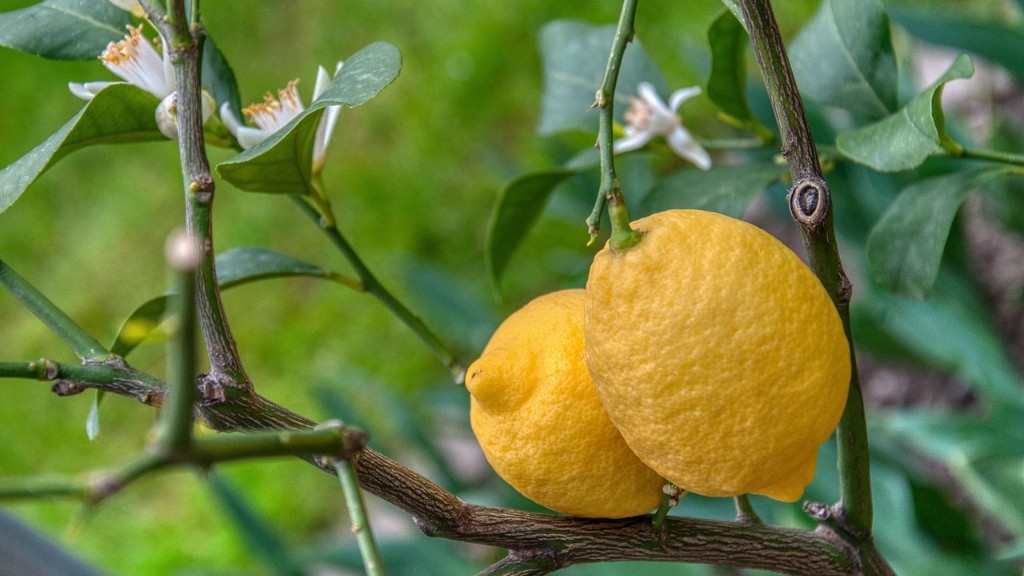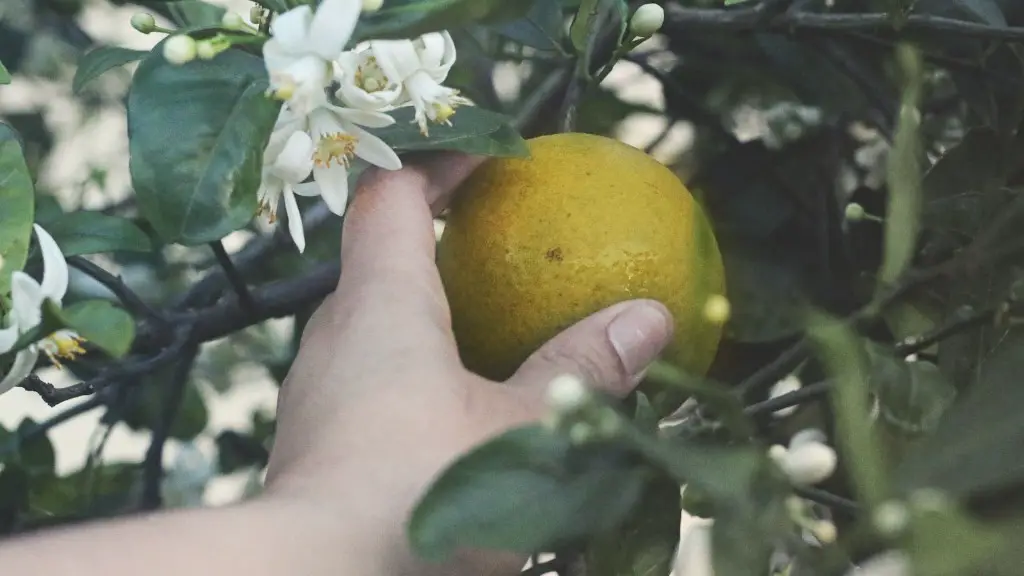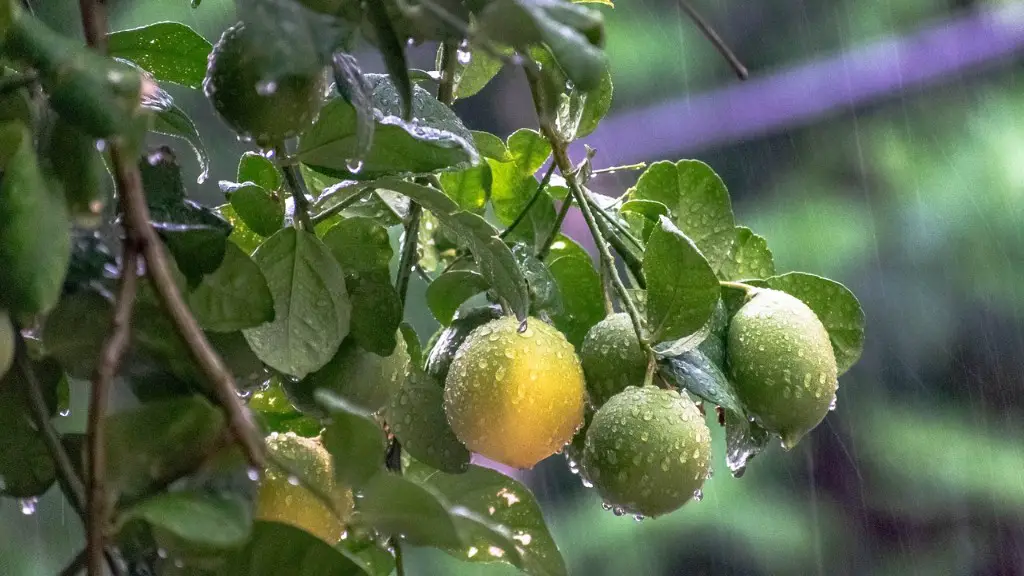Citrus trees, like lemons, are some of the most popular fruit trees in the world. Because of their hardy nature, they are relatively easy to grow and care for and will produce an abundance of excellent-tasting fruit with proper care and maintenance. To understand how a lemon tree bears fruit, one needs to consider the process and how the tree needs to be nurtured along the way.
At the most basic level, lemon trees rely on two important stages in their lifecycle to produce fruit. The first is known as flowering, which occurs in the early months of the year and involves the production of fragrant, showy flowers. As flowers are pollinated, as in any other flowering plant, a seed is produced and will eventually become a lemon. The second stage is called fruiting and involves the transformation of the seed into a full-fledged lemon.
In order for a lemon tree to bear fruit, it must have the proper growing conditions. Primarily, lemon trees need to be kept warm and supplied with water and nutrients. To ensure success, it’s important to give the tree plenty of sun and to regularly check for pest and disease, as citrus trees can suffer from a variety of issues if overlooked.
When it comes to care, regular pruning is essential as it will affect the shape, production and overall health of the tree. Pruning should be done annually in late winter, as this will help the tree become more productive while reducing the need for additional fertilizers. Thinning out heavy canopies is also important, as this will promote air flow, help make the tree more open and increase production.
In addition to creating a conducive environment, watering is an essential step in the growth of a lemon tree. Generally, it’s best to water the tree early in the day or late in the evening and to ensure that the soil is well drained. When it comes to fertilizers, a balanced formula should be used, as this will provide the tree with the additional nutrients it needs for healthy growth and fruit production.
At the end of the flowering and fruiting seasons, it is important to prune off any dead or diseased branches and to harvest the lemons when ripe. By understanding the basics of growing a lemon tree and providing the necessary care and attention, the chances of having a productive tree that bears lots of delicious, juicy fruit are significantly increased.
Soil Requirements
A lemon tree requires well-drained soil, as standing water can cause root rot and other detrimental effects. The soil also needs to be balanced, meaning it should contain a combination of sand, loam and clay, as this will ensure that it can retain the proper amount of moisture and nutrients to promote healthy growth and robust fruit production.
In addition to being nutrient-rich and well draining, the soil should also be slightly acidic. This means that pH levels should generally be between 5.5 and 6.5. As this may vary depending on the plant and geographic location, it is best to test the soil and make changes accordingly, if necessary.
It is also important to note that soil must be monitored and treated in the right way to maintain optimum conditions. Adding organic matter to the soil, such as compost or aged manure, can help improve soil structure, reduce compaction and increase water and nutrient absorption, as these materials help to create more air pockets in the soil.
Frequent watering should also be done throughout the flowering and fruiting seasons, as this will help keep the soil moist and promote growth and productivity. Subsurface mulches can be used to help conserve moisture, reduce weed growth and protect plant roots from high temperatures in the hotter months of the year.
Fertilization Needs
Fertilization is another key step in proper lemon tree care and should be undertaken in the spring and summer months prior to the fruiting season. A balance of nitrogen, phosphorus and potassium is recommended, as these are all essential for proper fruit production. A slow-release fertilizer is ideal, as these provide a consistent and steady release of nutrients.
In order to determine how much fertilizer is needed, the tree should be tested and soil adjustments made accordingly. Additionally, supplemental feeding of calcium and magnesium may be required if soil levels are insufficient. These two elements are especially important to lemon trees, as they both play an integral role in fruit development.
The amount of fertilizer needed by the tree should never be over-applied, as this can burn the roots and cause further damage. On the other hand, under-application can lead to nutrient deficiencies, stunted growth and poor soil conditions, so it is best to err on the side of caution and apply only what is needed.
Moreover, the use of fertilizer should be avoided during the cold winter months, as this will have little effect on the tree’s actual condition. Instead, the focus should be on providing enough water and nutrients during the flowering and fruiting periods, as this is when the tree will require them the most.
Pest and Disease Management
Unfortunately, lemon trees can suffer from various pests and plant diseases, and plants must be monitored closely in order to prevent any damage. Insects such as aphids, scale, mealybugs and citrus thrips can all adversely affect the tree’s growth and production, so careful attention should be paid to the leaves and fruit for any signs of infestation.
Common fruit and foliar diseases, such as citrus canker, black spot and sooty mold, can also take hold if not properly managed. In some cases, the use of natural remedies, such as pesticides and fungicides, may be necessary to control the spread of disease and infestation.
If such remedies are used, it is important to follow the manufacturer’s instructions and use them sparingly, as they can be toxic to bees and other beneficial insects, as well as human health. Spraying with a mixture of water, garlic and soap may be more effective, and when using commercial products, organic ones are usually a better choice.
It is also important to remember to remove any dead or infected branches and leaves, as these can harbor disease and hinder the tree’s ability to produce fruit. Regular pruning is also recommended, as branches and stalks can become too thick and dense, reducing air flow and creating a hospitable environment for pests and disease.
Harvesting
Lemon trees will generally start bearing fruit after around three to four years, and once they reach a certain size, they may produce an abundance of lemons throughout the season. These lemons will ripen to a yellowish-green color and then gradually progress to a bright yellow during the later months of the year.
When harvesting lemons, it is important to ensure that the fruit is fully ripened before picking, as green lemons may still be sour and will not taste as good. Lemons should also be plucked gently, as squeezing them too hard can damage the tree and reduce fruit production. It is advisable to pick lemons as they become ripe, once every week or two, in order to ensure they are not left on the tree too long.
When harvesting, it is also important to keep in mind that the tree may be producing more than it can handle, and it may be a good idea to thin out some of the fruit in order to ensure healthy growth and future production. If a tree is left as is, overloading can lead to poor fruit quality and smaller fruit.
When harvesting, it is important to use the right tools to ensure the lemons are not damaged in the process. The tree should be checked regularly and the lemons should be removed with the assistance of hedge shears, gloves or tongs, in order to avoid crushing or damaging the fruit.
Storage
Once harvested, lemon fruits should be stored in a cool, dry place, as heat can cause them to spoil quickly. To prolong their life, lemons should be stored in perforated plastic bags and kept in the refrigerator for up to three weeks. When storing lemons in the fridge, make sure to keep them away from apples and other fruits, as these will accelerate ripening.
If needed, lemons can also be frozen or dehydrated. To freeze them, simply cut them in half and scoop out the flesh, then wrap them in parchment paper or sealable plastic bags. To prepare for dehydration, slice the fruits into thin pieces and spread them out on a baking tray lined with parchment paper. Once dried, lemons can be stored in an airtight container for up to six months.
Lemons, either fresh or in other forms, can also be used in various different recipes. For example, they can be used in vegetable dishes, fruit salads, homemade preserves, marinades and dressings, and even in desserts.fresh
Lemon juice can be used in a wide variety of ways, such as a natural cleaner or an addition to water to make it more palatable. Alternatively, lemon zest can be used as a finishing touch to salads and other dishes to give them a burst of flavor.





